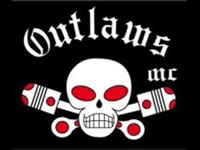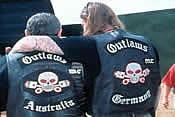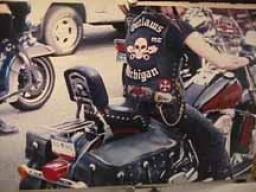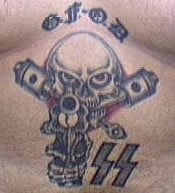Outlaws Motorcycle Club facts for kids
 |
|
| Abbreviation | A.O.A. |
|---|---|
| Founded | 1935 |
| Founder | John Davis |
| Founded at | McCook, Illinois, United States |
| Type | Outlaw motorcycle club |
| Headquarters | Chicago, Illinois, United States |
|
Region
|
Worldwide (441 chapters in 43 countries) |
|
Membership
|
4,000 |
|
International President
|
John "Tommy O" Erwin |
The Outlaws Motorcycle Club, also known as the American Outlaws Association (A.O.A.), is a large motorcycle club with members around the world. It was started in McCook, Illinois, in 1935. This makes the Outlaws MC the oldest motorcycle club of its kind in the world.
With 441 groups (called chapters) in 43 countries and over 4,000 members, it is also one of the largest motorcycle clubs globally. Most Outlaws members ride Harley-Davidson motorcycles. Some authorities see the club as being involved in serious illegal activities.
Contents
History of the Outlaws MC
The club began as the McCook Outlaws MC. It was founded by employees of the Electro-Motive Company at Matilda's bar on Route 66 in McCook, Illinois. This happened in 1935, and John Davis is said to be the founder.
The club was not active during World War II. However, it started up again afterward. Members attended the first big motorcycle gathering after the war in Chicago in May 1946.
Growing Across the United States
By 1950, the club started inviting more people from the Chicago area to join. It then changed its name to the Chicago Outlaws MC. The main office moved to the South Side of the city.
In 1964, the Outlaws joined with other motorcycle clubs. These included the Cult club from New York, the Gypsy Outlaws from Milwaukee, and the Gypsy Raiders in Louisville. This made the Outlaws the biggest "one percenter" club east of the Mississippi River. The term "one percenter" is sometimes used to describe motorcycle clubs that are not part of the American Motorcyclist Association.
On January 1, 1965, these clubs officially formed the American Outlaws Association. The Outlaws grew even more in July 1967. They welcomed the Iron Cross club in West Palm Beach into their group.
Documenting the Club's Early Days
The club was featured in a photo book called The Bikeriders in 1967. This book by Danny Lyon showed pictures and interviews about the lives of club members in the 1960s. Lyon spent four years riding with the Outlaws' Chicago group starting in 1963. He wanted to show the life of American motorcycle riders.
International Expansion
In 1977, the Outlaws became an international club. Several groups from the Satan's Choice Motorcycle Club in Canada joined them. The club continued to grow around the world. It expanded into France in 1993, Australia in 1994, and Norway in 1995. More chapters were later started across Europe.
In November 2006, the Outlaws became the first major motorcycle club of its kind to open a chapter in the Far East. This happened when a full group was started in Okinawa City.
Club Symbols and Insignia
The Outlaws' first symbol was a motorcycle inside a winged circle. This was painted on the back of members' jackets. In 1950, the club's logo changed. A small skull replaced the winged motorcycle, and a special style of letters was used.
In 1954, the Outlaws added crossed pistons to the small skull. This design was inspired by a movie. The skull and crossed pistons logo is known as "Charlie." It was redesigned in 1959 to be larger and more detailed. This "Charlie" symbol is a registered trademark.
In 1963, the Outlaws started wearing a diamond-shaped "1%er" patch. They were the first club east of the Mississippi River to do this. After officially forming the American Outlaws Association in 1965, the club added an A.O.A. patch to their "colors" (their vests). This patch shows a hand with an upstretched middle finger. It was made to be a playful copy of another motorcycle association's logo.
Members also wear a patch showing their rank in the club. An "S.S." patch with twin lightning bolts is sometimes given to members for certain actions. The Outlaws use black and white colors. They also use skull images and phrases like "Support Black & White" and "Support Your Local Outlaws."
Club Mottos
In 1969, the club adopted the motto "God forgives, Outlaws don't" ("GFOD"). The Outlaws have a long-standing rivalry with the Hells Angels. This has led to other phrases used by Outlaws members. These include "ADIOS," which stands for "Angels Die In Outlaw States." Another is "All Hells Angels must die," or "AHAMD."
Other mottos include "Snitches are a dying breed" and "Outlaws forever, forever Outlaws" ("OFFO"). Patches with these short forms are often worn by Outlaws members.
Becoming a Member
To join the Outlaws, a person must be a man over 21 years old. They must also own an American-made motorcycle that is at least 750cc. In the United States and Canada, Outlaws mostly ride Indian, Victory, and Harley-Davidson motorcycles. Outside of North America, members can ride motorcycles from any country, as long as they are in the "chopper" style.
There are five main things considered when someone wants to join:
- They own and ride a Harley-Davidson.
- They understand how motorcycles work.
- They live a lifestyle that fits with motorcycle culture and treat other riders like brothers.
- They are seen as strong and masculine in their attitude and actions.
- They follow the club's way of life instead of common societal values.
The Membership Process
To officially join, a person needs a current member to sponsor them. They start as an "associate" or "hangaround" to help the chapter. Then, they become a "prospect." If the club approves, a prospect moves to "probationary" or "probate" status. During this time, they must show their dedication to the club.
A probationary member wears a special patch on their vest that says "Probationary Outlaws." This period usually lasts several months. The highest level of membership is a "patched" or "patchwearing" member. This happens after all members of a chapter vote yes.
Once a full member, an Outlaw can wear a vest with the club's symbols, known as "colors." They can also attend weekly "church" meetings. The patch with the Outlaws emblem is surrounded by other patches called "rockers." These show chapter and club details. Club rules say that Outlaws patches must be worn on leather or black denim vests. Blue denim is not allowed. Members' wives or girlfriends are not allowed to wear club symbols. However, women connected to the club, called "old ladies," can wear vests that say "Property of the Outlaws." Outlaws are told to protect their colors with their lives. It is forbidden for any item with the club's logo to touch the floor.
Members must pay yearly dues and attend local, regional, and national events. Mandatory chapter "church" meetings are held weekly. Club motorcycle trips and parties, called "runs," happen throughout the year. National runs happen a few times a year, regional runs more often, and local runs usually weekly. Membership dues help pay for activities like memorials and group trips.
Outlaws members usually pay a fee if a fellow member needs legal help. All members, except chapter presidents, must take turns guarding Outlaws clubhouses 24 hours a day. Breaking rules can result in a fine. Members are also told to attend funerals of other Outlaws.
After a year of membership, Outlaws can get a tattoo of the club's symbol and mottos like "God forgives, Outlaws don't." After five years, members can get tattoos that look like their "colors" on their backs. Other tattoos might show membership details.
Members can leave the club in different ways: in "bad standing," "good standing," by retiring, or when they pass away. Retired Outlaws can wear a special "retirement style" shirt.
How the Club is Organized
Outlaws chapters are led by elected officers. These include a president, vice president, treasurer, and a "sergeant-at-arms." Chapters follow rules for elections, meetings, and actions against members who break club rules.
The club has 441 chapters in 43 countries across Asia, Europe, and North America. Each chapter has a clubhouse. These buildings are often protected with strong walls, steel doors, and video cameras. Clubhouses are used for meetings and parties.
Chapter presidents report to regional presidents, who manage different areas. These regions are named by color, like the red and blue regions. Regional presidents then report to the club's international president, who leads the entire Outlaws organization. Officers at all levels are chosen by the club members.
Outlaws Regions and Headquarters
The Outlaws' areas in the United States are divided into ten color-coded regions:
- Black region: Indiana and Michigan
- Blue region: Pennsylvania
- Copper region: North Carolina, South Carolina, and Virginia
- Gold region: Wisconsin
- Gray region: Tennessee
- Green region: Kentucky, Ohio, and Oklahoma
- Orange region: Florida
- Red region: New England and the Philadelphia area
- Silver region: Alabama and Georgia
- White region: Illinois
The Outlaws' international headquarters has historically been in the Midwest. The South Side, Chicago chapter was named the club's "mother chapter" in 1964. It is known as the "Mother Ship" among Outlaws members.
Support Clubs
Each main Outlaws chapter has one to five "support clubs." These are smaller motorcycle clubs that are connected to the Outlaws. Members of these clubs can attend Outlaws events and wear patches that show their support. They also help the Outlaws with tasks and guard duties.
The main support club for the Outlaws is the Black Pistons Motorcycle Club, which is active worldwide. Other support clubs include local groups like the Undertakers MC in Lexington, Kentucky. There are also regional clubs like the Chosen Few MC in Canada and New York. In Norway, the Outlaws oversee the Black & White Crew, a group whose members do not need to own a motorcycle.
See also
- List of outlaw motorcycle clubs
- The Bikeriders




